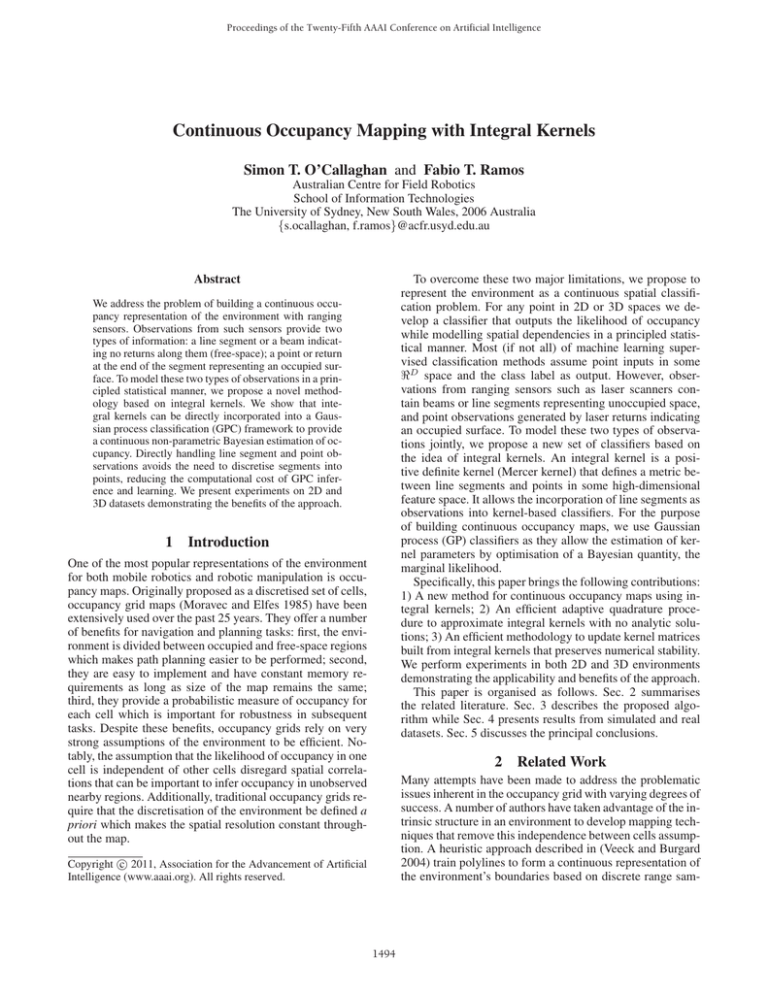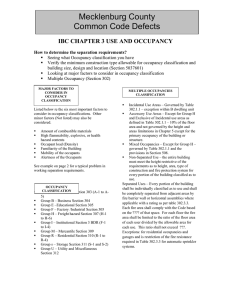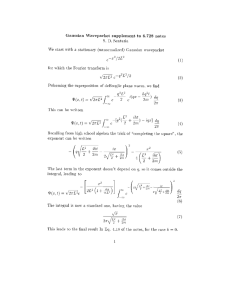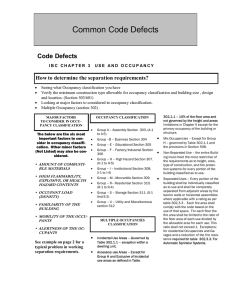
Proceedings of the Twenty-Fifth AAAI Conference on Artificial Intelligence
Continuous Occupancy Mapping with Integral Kernels
Simon T. O’Callaghan and Fabio T. Ramos
Australian Centre for Field Robotics
School of Information Technologies
The University of Sydney, New South Wales, 2006 Australia
{s.ocallaghan, f.ramos}@acfr.usyd.edu.au
To overcome these two major limitations, we propose to
represent the environment as a continuous spatial classification problem. For any point in 2D or 3D spaces we develop a classifier that outputs the likelihood of occupancy
while modelling spatial dependencies in a principled statistical manner. Most (if not all) of machine learning supervised classification methods assume point inputs in some
D space and the class label as output. However, observations from ranging sensors such as laser scanners contain beams or line segments representing unoccupied space,
and point observations generated by laser returns indicating
an occupied surface. To model these two types of observations jointly, we propose a new set of classifiers based on
the idea of integral kernels. An integral kernel is a positive definite kernel (Mercer kernel) that defines a metric between line segments and points in some high-dimensional
feature space. It allows the incorporation of line segments as
observations into kernel-based classifiers. For the purpose
of building continuous occupancy maps, we use Gaussian
process (GP) classifiers as they allow the estimation of kernel parameters by optimisation of a Bayesian quantity, the
marginal likelihood.
Specifically, this paper brings the following contributions:
1) A new method for continuous occupancy maps using integral kernels; 2) An efficient adaptive quadrature procedure to approximate integral kernels with no analytic solutions; 3) An efficient methodology to update kernel matrices
built from integral kernels that preserves numerical stability.
We perform experiments in both 2D and 3D environments
demonstrating the applicability and benefits of the approach.
This paper is organised as follows. Sec. 2 summarises
the related literature. Sec. 3 describes the proposed algorithm while Sec. 4 presents results from simulated and real
datasets. Sec. 5 discusses the principal conclusions.
Abstract
We address the problem of building a continuous occupancy representation of the environment with ranging
sensors. Observations from such sensors provide two
types of information: a line segment or a beam indicating no returns along them (free-space); a point or return
at the end of the segment representing an occupied surface. To model these two types of observations in a principled statistical manner, we propose a novel methodology based on integral kernels. We show that integral kernels can be directly incorporated into a Gaussian process classification (GPC) framework to provide
a continuous non-parametric Bayesian estimation of occupancy. Directly handling line segment and point observations avoids the need to discretise segments into
points, reducing the computational cost of GPC inference and learning. We present experiments on 2D and
3D datasets demonstrating the benefits of the approach.
1
Introduction
One of the most popular representations of the environment
for both mobile robotics and robotic manipulation is occupancy maps. Originally proposed as a discretised set of cells,
occupancy grid maps (Moravec and Elfes 1985) have been
extensively used over the past 25 years. They offer a number
of benefits for navigation and planning tasks: first, the environment is divided between occupied and free-space regions
which makes path planning easier to be performed; second,
they are easy to implement and have constant memory requirements as long as size of the map remains the same;
third, they provide a probabilistic measure of occupancy for
each cell which is important for robustness in subsequent
tasks. Despite these benefits, occupancy grids rely on very
strong assumptions of the environment to be efficient. Notably, the assumption that the likelihood of occupancy in one
cell is independent of other cells disregard spatial correlations that can be important to infer occupancy in unobserved
nearby regions. Additionally, traditional occupancy grids require that the discretisation of the environment be defined a
priori which makes the spatial resolution constant throughout the map.
2
Related Work
Many attempts have been made to address the problematic
issues inherent in the occupancy grid with varying degrees of
success. A number of authors have taken advantage of the intrinsic structure in an environment to develop mapping techniques that remove this independence between cells assumption. A heuristic approach described in (Veeck and Burgard
2004) train polylines to form a continuous representation of
the environment’s boundaries based on discrete range sam-
c 2011, Association for the Advancement of Artificial
Copyright Intelligence (www.aaai.org). All rights reserved.
1494
ples by employing user-defined optimisation criteria. A technique proposed in (Paskin and Thrun 2005) uses polygonal
random fields to probabilistically reason about occupancy,
rather than the boundaries, of the environment. The maps
generated are continuous and allow for inference to be made
in unscanned regions. However, this comes at considerable
computational cost.
More recently, GPs have become a popular tool for
robotic perception, (Smith, Posner, and Newman 2010;
Lang, Plagemann, and Burgard 2007), primarily due to
their ability to learn spatial correlation with noisy data in a
Bayesian setting. (O’Callaghan, Ramos, and Durrant-Whyte
2009) uses Gaussian processes to infer the hypothesis of
occupancy at any point in the environment. The technique
provides a continuous representation of the world that uses
Bayesian inference to estimate the probability of occupancy
in occluded or unscanned areas. Associated predictive variance maps indicate the degree of confidence the model has
in its estimates. (Bohg et al. 2010; Gan, Yang, and Sukkarieh
2009) uses these outputs to determine optimised exploration trajectories that maximise information gained about
the robot’s surrounds.
This paper takes a different approach to continuous occupancy maps by proposing novel kernels capable of providing
positive-semi definite matrices computed between line and
point observations. This has a number of benefits over previous methods including efficiency and accuracy. We present
a detailed description of the entire occupancy map algorithm
as follows.
3
Algorithm Description
A general overview of the proposed method is illustrated in
Fig. 1. Essentially, we treat the occupancy map as a form
of classification problem. The robotic platform makes range
observations of the real world environment. The resulting
occupied points and free-space line segments are actively
sampled (Section 3.4) and, if necessary, stored in a cellular data structure (Section 3.3). A Gaussian process is used
to perform an initial regression on processed sensor data
while a probabilistic least-squares classification algorithm is
then trained to identify regions of occupancy and free-space
based on the GP’s outputs (Section 3.1). The GP framework is extended to handle observations along line segments
rather than just deterministic points (Section 3.2).
3.1
Gaussian Process Occupancy Maps
Gaussian processes occupancy maps, GPOMs, essentially
use GPs to classify the environment into regions of occupancy and free-space using rangefinder sensor observations
as training data. GPs provide a powerful framework for
learning models of spatially correlated and uncertain data.
GP regression provides a robust method of prediction and
can handle incomplete sensor data effectively. They can be
viewed as a Gaussian probability distribution in function
space and are characterized by a mean function μ(x) and
the covariance function k(x, x∗ ).
Hence, the process itself can be thought of as a distribution over an infinite number of possible functions and in-
Figure 1: Block diagram of the proposed mapping methodology
ference takes place directly in the space of functions. By
assuming that the target is data jointly Gaussian, we obtain
f (x∗ ) = N (μ, σ),
(1)
where
−1
y,
(2)
μ(x∗ ) = k(x∗ , x)T k(x, x) + σn2 I
−1
σ(x∗ ) = k(x∗ , x∗ ) − k(x∗ , x) k(x, x) + σn2 I
k(x, x∗ ).
(3)
In the case of GP occupancy maps, the training and test
data, x and x∗ respectively, refer to physical locations in
space while the target data, y ∈ {−1, 1}, represents the
class label (free-space or occupied). k(x, x) or simply K is
the matrix of the covariances evaluated at all pairs of training inputs. Its elements are defined depending on a covariance function k parameterised by hyperparameters θ. σn2 is
the variance of the global noise. A detailed explanation and
derivation of the Gaussian process can be found in (Rasmussen and Williams 2006).
Gaussian processes are generally used in regression and
so an additional stage is required for classification problems. A probabilistic least-squares classifier, described in
(Rasmussen and Williams 2006) and (Platt 2000), uses the
GP’s predictive mean and variance functions to determine
the probability of occupancy for each query point:
αμ(x ) + β ∗
p(Occupancy|x∗ ) = Φ
.
(4)
1 + α2 σ(x∗ )2
Here, Φ is the cumulative Gaussian function while α and β
are parameters that are optimised by performing leave-oneout cross-validation on the training set. Using the resulting
distribution, the environment can be classified into occupied,
free-space and unsure regions using user-defined thresholds
that depend on the desired level of greediness.
3.2
Integral Kernels
The conventional Gaussian process occupancy map described in (O’Callaghan, Ramos, and Durrant-Whyte 2009)
has some drawbacks, mainly due to the manner in which
the free-space observation is represented in the model. Extracting the closest points on nearby line segments to the test
point results in unique training data and consequently unique
K matrices for each query. Hence a new matrix must be inverted to evaluate Eq. 2 and 3 each time P (Occupancy|x∗ )
is required.
Additionally, it is necessary to discretise the line segment
into multiple free-space points during training to approximate a continuous sensor beam. This can inflate the size of
the training set to impractical levels and slow the optimization of the hyperparameters considerably due to the O(n3 )
nature of the algorithm.
Both of these issues can be solved by extending the
Gaussian process framework to model the continuous sensor beam directly as a path integral over a line segment. A
method for handling integral observations using linear operators is proposed in (Murray-Smith and Pearlmutter 2005;
Osborne 2010) which discretises the line segment in a similar manner as the trapezoidal rule. This approach greatly
increases the size of the training set. Consequently we propose a novel approach in which we redefine the covariance
function itself to handle a line segment as a single continuous observation.
Definition 1. (Integral Kernel) Let l1 : [a, b] → C1 and l2 :
[c, d] → C2 be two arbitrary bijective parametrizations of
curves C1 and C2 respectively such that l1 (a) and l1 (b) give
the endpoints of C1 and l2 (c) and l2 (d) give the endpoints of
C2 . Let k(·, ·) be a symmetric positive semi-definite function
(Mercer kernel) that maps k : [e, f ] × [e, f ] → . We define
the integral kernel kII of k with respect to l1 and l2 as
b
kII (l1 , l2 ) =
a
d
k(l1 (u), l2 (v))dudv,
(5)
c
which exists and is finite.
Similarly, an integral kernel can be defined between a parameterised curve l(u) : [a, b] → C and a point x as
b
kI (l, x) =
k(l(u), x)du,
(6)
a
where l(a) and l(b) are the endpoints of the curve C. It follows from the definition of positive semi-definite kernels
KII KI
that the kernel matrix computed as
is also
KIT K
1
positive semi-definite.
For the purpose of continuous occupancy maps, the
curves C are line segments. For example, the 2D line
segment from (a, b) to (c, d) is defined as l(u) =
(x(u), y(u)) = (a + u(c − a), b + u(d − b)), u ∈ [0, 1].
1
proof omitted due to space constraints.
Integral squared exponential. Consider the integral kernel for the commonly used covariance function, the squared
exponential:
(x − x )2
2
k(x, x ) = σf exp −
(7)
2l2
where σf and l are the hyperparameters representing the signal variance and length-scale, respectively. The closed-form
solution for the squared exponential covariance function applied to Eq. 6 can be determined for the 1-D case,
b − x a − x
π
2
kI (l(u), x) = σf l
− erf √
. (8)
erf √
2
2l
2l A closed-form solution for the n-dimensional case can be
obtained similarly.
Adaptive Order Quadrature. While an analytical solution exists for Eq. 6 in the squared exponential case, numerical integration is required to determine the solution for
Eq. 5. In the proposed implementation, the Clenshaw-Curtis
quadrature, (Gentleman 1972), is employed primarily because of its fast-converging accuracy compared to Gaussian
quadrature rules and its applicability to numerous families of
covariance functions. We propose an adaptive version of the
quadrature whereby the order, o, or number of sample points
adjusts to suit length of the line segment as well as the covariance function’s length-scale. This approach ensures an
efficient sampling technique that reduces the risk of producing non-positive definite matrices while also decreasing the
overall number of sample points.
This quadrature approximates an integral by a weighted
sum as:
o
f (u)du ≈
wi f (ui ),
(9)
i=1
where w and ui are respectively the weights and locations of
the sample points specified in (Gentleman 1972). The order
of the quadrature for each line is determined by temporarily warping the lengths of the segments so as to normalise
the length-scale hyperparameters, l. o is then assigned based
on the length of each warped segment. Consequently, long
lines or models with short length-scales are automatically
sampled more densely compared to shorter lines or smoother
functions.
The quadrature can equally be used to evaluate the solution to Eq. 6 for other covariance functions such as the
Matèrn family (Stein 1999).
Target Vector Behaviour For regression with integral
kernels, the target vector y represents the net area under the
function f (∗), along each line segment. Extending this to
classification, the target for each line observation becomes:
yi = Classi ∗ |ab|i ,
(10)
th
where Classi is the class label (-1 or +1) of the i observation and ab is the line segment. Figure 2 illustrates the application of integral kernels to a simulated regression problem.
The ground truth is noisily sampled using both line and point
observations.
3.4
Active Sampling
The frequency of required updates to the model can also
be greatly reduced by filtering the incoming observations.
Essentially, the information gained from adding each new
training point is determined using an active sampling technique. The Kullback-Leibler divergence is used as a metric
to evaluate the benefit of including a new observation by
comparing the mean and variance at a location before and
after the training point is added. Using a threshold specified
a priori, points below a certain Kullback-Leibler divergence
are rejected. Consequently, the sampling rate is naturally
adjusted by environment complexity. This threshold can be
tuned to balance speed with accuracy depending on the intended application. A similar active sampling technique is
described in (Smith, Posner, and Newman 2010).
Figure 2: 1-D example. The dataset consists of both line and
point observations.
4
4.1
3.3
Updating the Covariance Matrix and
Limiting the Size of K
A key benefit to our proposed approach is the ability to store
a covariance matrix, K, that is applicable to multiple query
points. Consequently, K −1 need only be computed once
thus eliminating the O(n3 ) computational bottleneck of the
algorithm proposed in (O’Callaghan, Ramos, and DurrantWhyte 2009). During online operation, however, it is necessary to perform iterative updates of K to incorporate additional observations into the model. The matrix inversion
lemma is usually applied in these cases but it can damage
the numerical stability of the inverted matrix. We therefore
resort to a more stable procedure based on Cholesky factor
updates (Osborne et al. 2008). Consider the positive definite
matrix, [K1,1 ] with Cholesky decomposition
[R1,1 ]. Given
K
K
1,2
a new positive definite matrix K1,1
Its Cholesky de2,1 K2,2
S
S1,2
composition, 1,1
0 S2,2 can be updated as:
S1,1 = R1,1
(11)
T
S1,2 = R1,1
\ K1,2
(12)
T
S1,2 ).
S2,2 = chol(K2,2 − S1,2
(13)
This reduces the computational complexity of an update
from O(n3 ) to O(n2 ). Inevitably, even this more efficient
implementation becomes impractical as more observations
are added and the covariance matrix grows to an intractable
size. A number of solutions have been suggested to address
this scalability issue such as Bayesian Committee (Tresp
2000). Here, we split the covariance matrix once it reaches
an unacceptable size and begin to grow a new model with
the incoming observations. It is important to note that we
are not discretising the map like what is done in occupancy
grids but instead we are partitioning the data into more manageable cells.
Experimental Results
Simulated Data
Initial tests were carried out using synthetic datasets which
provided known ground truths. Fig. 3 illustrates the results
from a 2-D experiment in which two robots navigate a room
taking range observations. Over 26 scans, a total of 249 laser
returns were logged. The layout of the environment as well
as the occupied points and free-space line segments used as
training data are shown in Fig. 3(a). The resulting occupancy
map and associated predictive variance produced using GPs
with Integral Kernels, GPOMIK, are presented in Fig. 3(b)
& (c), respectively.
Using Bayesian inferences the mapping technique produces a continuous underlying function representing the
probability of occupancy for the entire region. After coarsely
sampling this function at a resolution of 0.5 x 0.5 m, it is can
be seen that the map bears a close resemblance to the ground
truth. Walls and obstacles are assigned a high probability of
occupancy while the free-space regions of the environment
are deemed unlikely to be occupied despite significant distances between observations in areas. Predictions made in
regions devoid of any measurements (such as the lower left
corner) are accompanied by a rise in variance.
The availability of a ground truth makes it possible compare various mapping techniques. Fig. 3(d) shows the Receiver Operator Characteristic or ROC curves for the proposed GPOMIK approach as well as the previous Gaussian Process Occupancy Map approach, GPOM, described
in (O’Callaghan, Ramos, and Durrant-Whyte 2009), and
the occupancy grid. The independence-of-cells assumption
made by the occupancy grid results in large areas of the
map remaining unaltered from the prior and explains why
it under-performs compared to the Bayesian approaches. By
representing the free-space beams as true line segments in
the model, our approach benefits from having more representative training data which leads to more suitable hyperparameters. Additionally, all query points share the same
training data so K is only calculated once and contains information from all observations as opposed to the k-nearest
neighbour strategy used by the GPOM. The comparisons are
quantified in Table 4.1.
Table 1: Quantitative comparison of experimental results
Area under
the curve
GPOMIK
Previous GP Method
Occupancy Grid
No Discrimination
0.9441
0.9162
0.8938
0.5
False positive rate
when True positive
rate = 0.90
0.101
0.7957
0.219
0.9
The theory can also be applied to 3-D datasets as demonstrated in Fig. 4. The top image shows the true state of the
environment as well as the locations of laser returns selected
as training data by the active sampler. From 1024 observation pairs (laser beam and hit), the active set was reduced
to 471 points and 217 line segments. The lower subfigure
shows all query points that were classified as occupied and
whose variance was below a certain threshold. As GPOMIK
models occupancy rather than a surface, representing problematic features such as overhangs is trivial.
Computationally, the GPOMIK iteratively builds and
stores a model making the subsequent evaluation faster than
the GPOM which must compute a small local model for each
query point. In this instance, the model was developed as
measurements were received along the trajectory lasting 65
seconds. Fig. 5 compares the times taken for the GPOMIK
and the previous method proposed in (O’Callaghan, Ramos,
and Durrant-Whyte 2009) to evaluate the model over a range
of resolutions. The proposed method requires, on average
6.06 seconds to evaluate 35,000 query points versus the
68.31 seconds needed by the previous approach. In a situation where the global model is not grown incrementally as
observations are received but instead has to be calculated
from scratch, the GPOMIK becomes computationally more
beneficial after approximately 40,000 queries.
4.2
Figure 3: 2-D Simulated Dataset.(a) Plan view of room.
Robot poses are shown as red diamonds. Observed occupied
points and free-space line segments are represented by green
crosses and blue lines, respectively. (b) Probability of occupancy versus location. (c) Predictive variance map.(d) ROC
curve comparing the performance of the proposed GPOMIK
method against the algorithm described in (O’Callaghan,
Ramos, and Durrant-Whyte 2009) and the occupancy grid
on a simulated dataset with known ground truth.
Real Data
A Riegl LMS-Z620 lidar was used to gather range measurements from a fixed position on a university green area.
30,000 laser returns were provided as inputs to the algorithm
from which the active sampler selected approximately 30%
as training data, Fig. 6(a). The maximum size of each covariance matrix, K, was limited to increase the overall performance speed, Sec. 3.3, resulting in 291 cells. Once K and
its inverse are determined and stored for each cell, querying the probabilistic model is fast. Eq. 2 & 3 now become
O(n2 ) operations, where n is the number of training points
in the relevant cell. Importantly, as the test points are independent of one another, constructing the occupancy map is
easily parallelizable.
After querying the model at a resolution of 0.5 x 0.5 x
0.5 m, resulting in 909416 test points and an evaluation time
of 63 seconds, the points that were classified as occupied
and with a variance below 1 were extracted and plotted in
Fig. 6(b & c). RGB data is added to Fig. 6(b) using information from a more detailed scan to aid with the interpretation
of the image. Walls, park areas and trees are identifiable in
Figure 5: Time comparison between the GPOMIK and the
GPOM on the 3D simulated dataset.
Figure 4: 3D Simulated Room Experiment. (a) Ground Truth
with rangefinder sensor poses shown as red diamonds and
the laser returns used after active sampling shown in blue
dots. (b) Plot of test points labelled as occupied by the classifier.
with problems were observations arrive not as points but as
lines, areas or volumes in 3D space. This leads to more accurate algorithms as the physicality of the problem is better
represented.
We believe that Gaussian process occupancy maps with
integral kernels will have a large range of applications, from
navigation tasks in mobile robotics, to object representation
in grasping problems. The work can be extended to include
noisy observations as in (O’Callaghan, Ramos, and DurrantWhyte 2010) or to infer object classes for occupied regions.
The ability of the technique to handle very sparse data sets
and still recover the general shape of the environment is very
encouraging as demonstrated in our 3D examples.
Acknowledgements
both viewpoints despite the relative sparseness of the training data and occlusions created in a number of areas. A ROC
curve of the outputted map was generated using unused observations as the ground truth. The area under the curve was
0.958 with a false positive detection rate of 0.076 for a true
positive rate of 0.9. In some regions, the occlusions are too
large to make a reliable classification such as close to the
centre of Fig. 6(b). The variance also increases in these areas and could be used as a metric to decide where additional
observations should be made.
5
Conclusions
In this paper, we presented a new occupancy map technique
based on integral kernels. Our method is able to model observations from both line segments representing laser beams
and points representing laser returns. Even though the paper explored the use of integral kernels for mapping tasks
in robotics, the technique is general and can be used to deal
This work is partially supported by the Australian Research
Council (ARC).
References
Bohg, J.; Johnson-Roberson, M.; Björkman, M.; and Kragic, D.
2010. Strategies for multi-modal scene exploration. In Proceedings of the 2010 IEEE/RSJ International Conference on Intelligent
Robots and Systems.
Gan, S.; Yang, K.; and Sukkarieh, S. 2009. 3d path planning for
a rotary wing uav using a gaussian process occupancy map. In
Proceedings of the Australasian Conference on Robotics and Automation (ACRA 2009).
Gentleman, W. M. 1972. Implementing clenshaw-curtis quadrature, i methodology and experience. Commun. ACM 15:337–342.
Lang, T.; Plagemann, C.; and Burgard, W. 2007. Adaptive nonstationary kernel regression for terrain modeling. In Robotics: Science and Systems (RSS).
Moravec, H., and Elfes, A. E. 1985. High resolution maps from
Figure 6: Real outdoor 3D dataset. (a) Training Points. (b & d) Test points that were classified as occupied by the classifier with
a variance less than 1. Colour and an inset showing a section of the environment are added to (b) for visualisation purposes.
The viewpoints in (a) and (b) are identical. (c) Aerial image of mapped environment from a similar orientation as (d)
wide angle sonar. In Proceedings of the IEEE International Conference on Robotics and Automation, 116–121.
Murray-Smith, R., and Pearlmutter, B. 2005. Transformations
of gaussian process priors. In Winkler, J.; Niranjan, M.; and
Lawrence, N., eds., Deterministic and Statistical Methods in Machine Learning, volume 3635 of Lecture Notes in Computer Science. Springer Berlin / Heidelberg. 110–123.
O’Callaghan, S. T.; Ramos, F. T.; and Durrant-Whyte, H. 2009.
Contextual occupancy maps using gaussian processes. In ICRA’09:
Proceedings of the 2009 IEEE international conference on
Robotics and Automation, 3630–3636. Piscataway, NJ, USA: IEEE
Press.
O’Callaghan, S. T.; Ramos, F. T.; and Durrant-Whyte, H. 2010.
Contextual occupancy maps incorporating sensor andlocation uncertainty. In ICRA’10: Proceedings of the 2010 IEEE international
conference on Robotics and Automation. Piscataway, NJ, USA:
IEEE Press.
Osborne, M.; Rogers, A.; Ramchurn, S.; Roberts, S. J.; and Jennings, N. 2008. Towards real-time information processing of
sensor network data using computationally efficient multi-output
gaussian processes. In International Conference on Information
Processing in Sensor Networks (IPSN 2008), 109–120.
Osborne, M. A. 2010. Bayesian Gaussian Processes for Sequen-
tial Prediction, Optimisation and Quadrature. Ph.D. Dissertation,
University of Oxford.
Paskin, M., and Thrun, S. 2005. Robotic mapping with polygonal
random fields. In Proceedings of the Conference on Uncertainty in
Artificial Intelligence, 450–458.
Platt, J. C. 2000. Probabilities for SV machines. In Advances in
Large Margin Classifiers, 61–74. MIT Press.
Rasmussen, C. E., and Williams, C. K. I. 2006. Gaussian Processes
for Machine Learning. MIT Press.
Smith, M.; Posner, I.; and Newman, P. 2010. Efficient nonparametric surface representations using active samplingfor push
broom laser data. In Proceedings of Robotics: Science and Systems
VI.
Stein, M. 1999. Interpolation of Spatial Data: Some Theory for
Kriging. New York: Springer.
Tresp, V. 2000. A bayesian committee machine. Neural Comput.
12:2719–2741.
Veeck, M., and Burgard, W. 2004. Learning polyline maps from
range scan data acquired with mobile robots. In In Proceedings of
the IEEE/RSJ International Conference on Intelligent Robots and
Systems (IROS).






